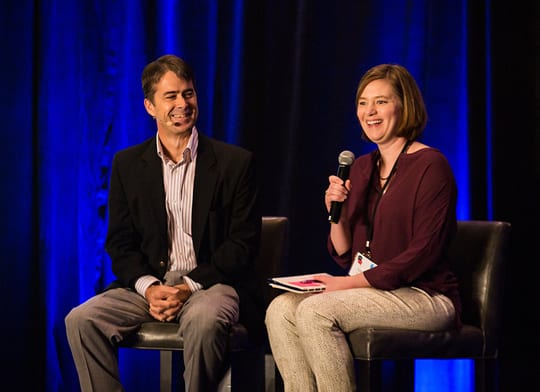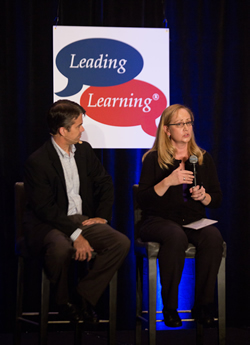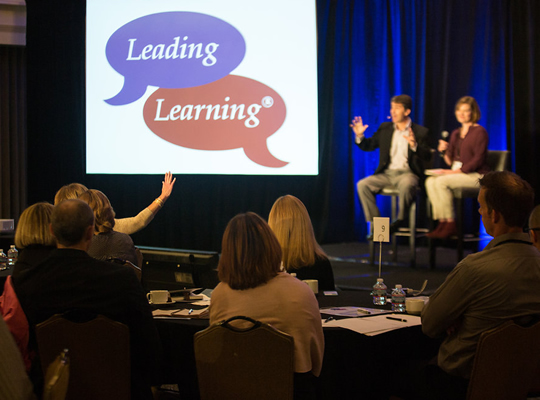
Here at Tagoras we help organizations in the businesses of lifelong learning, and we’re in that business ourselves. This is the final post in a three-part series that unpacks a few of the ways we’ve rethought typical learning formats at Tagoras events. (Read the first post, about Curated Connections TM, and the second post, about Dynamic PanelsTM.)
In each post, I share why we used the approach and explain the how of the approach, to make it as easy as possible for you to try it out, whether as is or with tweaks.
The focus in this post is on a format we’ve heard referred to as a “hot seat.” In fact, we used the term “hot seat” at our two-day placed based Leading Learning Symposium. But we rebranded the format for our Learning • Technology • Design virtual conference as Collaborative Coaching™ (sounds less intimidating while still being descriptive, we think).
As with Curated Connections and Dynamic Panels, we see potential for all these formats in different contexts—online and off, with smaller and larger groups, and so on. If your organization offers learning events (or wants to start), read on to find out more about Collaborative Coaching and whether it might be a fit for your organization.
Collaborative Coaching: The Why-To

Malcolm Knowles, the poster boy for andragogy, asserted (among other things) these two points:
- Adult learners tend to be most interested in subjects and skills that have immediate relevance to their work and life.
- Adult learners tend to be problem-centered rather than content-centered.
Those two motivators of adult learners makes the hot-seat format, or Collaborative Coaching, a natural fit.
A learner volunteers to be in the hot seat—at a place-based event, this is an actual stool or chair where other learners can see and hear her; in a virtual event, it might mean she’s visible on via a Web cam and heard via a mic.
The volunteer briefly shares a problem or an opportunity she wants help with, and then the other learners offer her, in rapid-fire fashion, ideas for how to address the problem or seize the opportunity. The person in the hot seat listens, but shouldn’t respond during the rapid-fire suggestions. At the end, the facilitator offers her two cents, and then the person in the hot seat may choose to respond to the feedback and advice offered, but she should do so briefly—sometimes a simple “thank you” suffices.
The expression “being in the hot seat” refers to a high-pressure situation where attention and scrutiny are focused on a particular person or entity, and it can be unnerving for some people to be the focus of attention. But the the learning potential for the recipient of the Collaborative Coaching, the person in the hot seat, is apparent—she gets to raise an issue that matters to her (so it’s relevant), and she receives ideas and advice for how to deal with that issue (so it’s problem-centered)—and those benefits usually outweigh any discomfort the Collaborative Coachee experiences.
The learning potential for those providing the Collaborative Coaching may not be as apparent, but it’s there.
- By its nature, Collaborative Coaching is participatory and active—anyone can contribute advice or a suggestion
- Learning events often are organized for a particular group of people or around a particular issue. That means the odds are good that the issue raised by a Collaborative Coachee is a relevant issue for other learners too.
- Whether the particular issue is relevant to other learners, the process is relevant for all learners. Seeing and hearing how others think through an issue can yield insights applicable to other challenges.
- Lastly, I’ll return to another premise of Knowles’s: Adults respond better to internal motivators than external motivators. The altruistic jolt of helping someone else can be a great internal motivator.
As you’ll know if you’ve read the prior posts in this series or followed our work for any amount of time, we’re big believers in peer learning and social learning. Collaborative Coaching harnesses both.

Collaborative Coaching: The How-To
Here are the major aspects of how we handled Collaborative Coaching, AKA hot seats, before and at the learning event. (What follows is based on what we did at the Leading Learning Symposium, a two-day place based event. We’ve since applied a very similar approach to use Collaborative Coaching as part of our annual Learning • Technology • Design virtual conference. (Yes, this works very well in a virtual environment, too.)
Before the Event
- We thought about when to include the Collaborative Coaching in the context of the overall event.
We opted to include the hot seats as part of some of the plenary sessions rather than in break-out sessions, to ensure all attendees were exposed to the format and to give us the biggest possible pool of both coachees and advice-givers.
We had a relatively small group (around 80 attendees), and so a hot seat in the full-group setting was manageable. If you have a larger group at a learning event, it would be preferable to conduct the Collaborative Coaching during break-out sessions or some context where you have fewer attendees.
We had an opening and closing plenary session each of the two days of the Leading Learning Symposium, and our plan was to incorporate at least one hot seat into at least two of those plenary sessions. In the end, we hit that minimum—we did two hot seats over the course of the two days. I would have liked to see us manage three, or even four, over the two days, but timing for the hot seats and the other components of the plenaries precluded that in the end.
- We recruited a pre-volunteer.
We looked through our attendee roster and looked for some likely candidates, and then we e-mailed them. Below is slightly redacted version of our e-mail.
Hi, [participant’s name],
Hope you are well. We are, as you might imagine, deep in the final throes of planning for the symposium. One thing we are really hoping to be able to do as part of the general sessions is have some attendees participate in “hot seats.”
In case you aren’t familiar with the concept, the idea is that an attendee volunteer tells the group of attendees, as concisely as possible, about a challenge/opportunity with which she is wrestling. Members of the group then have the opportunity to ask clarifying questions, as needed, and provide rapid-fire advice, tips, etc., based on their own experience or simply on having a different, outside perspective. The volunteer who presents the challenge/problem commits to listen fully to feedback from the audience—not defend her position, etc.—and, in the end, indicate any ideas/feedback, etc., she has found particularly helpful and may put to use.
We’ve found this to be a highly valuable exercise in our own professional development experiences—both for the person who is in the “hot seat” (which, is usually literally a stool or chair in the front of the room) and for the audience.
Because it is so valuable, we would really like to be able to do this at the symposium. BUT, we don’t want to ask for volunteers only to hear crickets chirping and birds cheeping. So, I’m reaching out to a handful of people who I think *might* actually be excited by this type of learning opportunity and be willing to pre-volunteer.
Any chance you would be game for doing a “hot seat” at some point during the event?
In addition to preventing crickets, finding a pre-volunteer (and we did identify one hot-seat volunteer before the symposium, and the second Collaborative Coachee was someone who volunteered at the symposium) also allowed us to stack the deck a bit. We were able to go into the first hot seat with an attendee likely to heed the instructions regarding brevity, not being defensive in response to suggestions, etc., and that allowed us to model the format effectively that first time we used it.
At the Event
- We thought about how best to use the meeting space.
We used stools on the main stage for the Collaborative Coaching—one for the coachee and one for one of us (i.e., the facilitator). We thought having one of us sitting alongside the coachee would not only make sense given our facilitator duties but would also help mitigate any stress the coachee might feel sitting in front of a room, as the center of attention. The coachee and the facilitator each had a mic. We also had a couple of mics and mic-runners on the floor to get to attendees who had suggestions for the coachee.
- We covered the ground rules, coordinated the rapid-fire feedback, and offered our two cents.
As the facilitators, we explained how the format working, focusing on the ground rules for those providing feedback: Ask clarifying questions of the coachee after she finishes laying out her issue or challenge only if really necessary. Otherwise, focus on suggestions. Be brief.
We also addressed the fact that the coachee’s specific issue or challenge might not be immediately applicable to all attendees—but all attendees could find something useful in the process and in the framing of issues, challenge, and suggestions.
We oversaw the flow of the hot seat, asking the coachee to state her issue or challenge, then calling on attendees (who’d raised their hands) to share their suggestions, and managing time.
After attendees had provided their suggestions and before the coachee was given the opportunity to say anything in closing, we offered our own thoughts and suggestions around the issue or challenge presented, which may involve summarizing or reiterating some of the earlier suggestions. This is a key piece, as it helps solidify the learning for all involved and ensures the activity wraps up intentionally rather than petering out as suggestions dry up or ending abruptly when time’s up.
- We recorded the hot seats.
We were recording all the plenary sessions, including the Collaborative Coaching. We provided the video recording of their hot seat to the volunteers. That was a value-add for them, as they could review not only the feedback they received but also to listen to and see themselves explaining the issue or challenge and think about how they might improve their communication on that front.
If you’re not set up for recording at the event where you use Collaborative Coaching, you could identify one or more volunteers (on your staff or other attendees) to take notes for the coachee—it can be hard for the coachee to keep up with all the rapid-fire suggestions.
The Epitome of Andragogy
Collaborative Coaching has been valuable in my own professional development (where I participated as a learner) as well as in learning events we at Tagoras have hosted and organized. Grounded in relevance to the learner, a problem-focused approach, and active participation, Collaborative Coaching is arguably the epitome of adult learning. So, if you haven’t tried it before, it may well be a format worth considering for one of your upcoming learning events.
Celisa
See also:


Leave a Reply